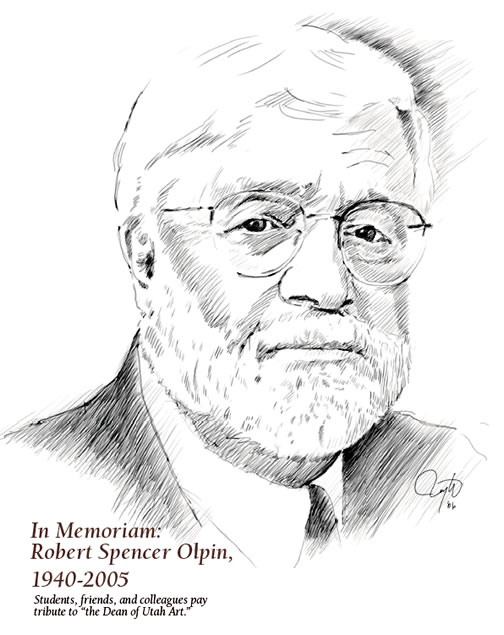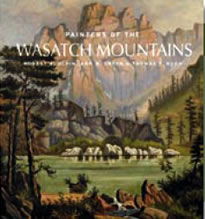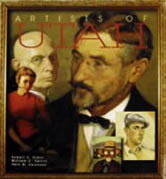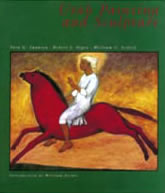
Vol. 15 No. 4 |
Spring 2006 |

William C.
Seifrit, co-author of Utah Art and Utah Art, Utah Artists: 150
Years Survey
During preparations for our first book [Utah Art, 1991], Bob,
Vern [Swanson, director of the Springville Museum of Art], and I met regularly
at a local restaurant. After the book’s publication, we discovered
that we missed getting together and decided to continue our monthly meetings.
Eventually we began asking some of our other “nerdy” friends—collectors,
historians, art fans—to join us, and the “Art Nurdz”
group was born. The only rule the Nurdz adopted was that there were no
rules: no minutes taken and no decisions made, other than the date for
the next meeting. Someone would occasionally bring a piece of art they’d
picked up, which prompted Vern to describe the gathering as ‘bring
and brag.’ Eventually there were anywhere from five to 20 people
who showed up each month.
Besides the Art Nurdz, Bob and I just enjoyed hanging out. We had a lot of fun during his recent sabbatical [Fall Semester 2005]. We were on campus for a meeting, had lunch, then hung around the Utah Museum of Fine Arts, being rude and making loud comments. It was in the Renaissance gallery that I introduced Bob to the concept of the ‘Bent-necked Virgin School of Painting’ [a jocular reference to many of the late medieval/early Renaissance artists’ stylized renderings of a long-necked Virgin Mary bending to gaze at the Christ child]. At that, Bob roared with laughter, managing to alarm security. We had a wonderful time that day.
At the October Nurdz meeting [at Urban Bistro], Vern handed me a letter that he’d written to a vice president at the U supporting Bob’s nomination as professor of the year. He asked me to read it to the group, as Vern had to leave. When we were breaking up lunch that day, I asked Ricc [Esparza], the owner, to turn off the music so I could read it to the group. Bob thanked me, and that following Friday morning he had a stroke.
Tom Alder, Vice President, Private Client Services, Zions Bank, and graduate student in art history
 I
took Bob’s course on Art Life in Utah, American Art I, then American
Art II. I loved doing the research and writing papers. After the three
courses, Bob suggested that I stop messing around and apply for the master’s
program. It was very difficult for me, a nontraditional student with a
B.S. degree in business, less than a 4.0 GPA, and no second language.
(I jokingly asked Bob if Canadian would count.) We persevered together,
and Bob always guided and encouraged me.
I
took Bob’s course on Art Life in Utah, American Art I, then American
Art II. I loved doing the research and writing papers. After the three
courses, Bob suggested that I stop messing around and apply for the master’s
program. It was very difficult for me, a nontraditional student with a
B.S. degree in business, less than a 4.0 GPA, and no second language.
(I jokingly asked Bob if Canadian would count.) We persevered together,
and Bob always guided and encouraged me.
The reason Bob was so loved by his students is that he celebrated our individuality. He had the very rare quality of treating his students as if each were his favorite. And he had a passion for ‘good’ art. When asked what art is, he would reply, ‘It’s the good stuff.’ And bad art? ‘It’s the other stuff.’ Bob was very proud of his last book, Painters of the Wasatch Mountains. He said a number of times that he felt Utah painters and their mountain subjects com- pared to the Hudson River School. The book is destined to be another top seller and is a wonderful, lasting legacy.
Clayton R. Williams, CEO of Williams Fine Arts, and art collector
I first met Bob 14 years ago. I was the new kid on the block, having switched from left-brain to right-brain thinking. I had been an engineering graduate and owned my own company, which I sold to become a painter. I did that for a while, and then decided to run an art gallery.
One day I sat down at a U of U function and happened to be next to Bob. He was dean of the College of Fine Arts at the time and asked me if I’d like to be on the U of U Development Review Committee, of which he was chair. It was a great leap of faith on his part, but I always had his support. I served with him in six or seven different positions at the College of Fine Arts, and he and I founded the Utah Fine Arts Institute [which Olpin co-directed and which now annually grants one scholarship each to an art history major, music history major, and two interdisciplinary students]. A couple years ago, we interviewed a young man who was focusing on fine art-medicine. His father had lost an ear to cancer, and he wanted to help restore it. We awarded him a scholarship, and he enrolled in art courses along with his medical studies. Next year he reported that he was working for the Huntsman Cancer Institute creating artificial noses. (See “The Art of Recovery,” Continuum, Fall 2004.) Committees and politics don’t always sail well together, but to sway people, Bob always said, ‘I’m just going to love ’em into it.’
Anne Dolowitz, docent at the Utah Museum of Fine Arts, docent trainer, and art collector
I met Bob when I took his class on 19th-century art. I was training to be a docent and took every course he offered, including an honors course in the summer, and I went on all his field trips. He asked me to join the Art Nurdz, as well as the spinoff group called the Starbucks Nurdz, who met once a week at a local coffeehouse. I didn’t feel I was qualified to join, but Bob said that membership wasn’t based on one’s art background; it was just a group of people who enjoyed getting together. We met monthly at Urban Bistro, across from the old library [in downtown Salt Lake City]. The owner, Ricc, is going to name Bob’s favorite Reuben sandwich after him.
Vern Swanson, Director, Springville Museum of Art, and co-author of Utah Art and Utah Art, Utah Artists: 150 Years Survey
I was a student of Bob’s in the master’s program [in 1971-72]. He was a nurturer—the kind of person who made you feel you had something special to offer. That was the first secret of his professional success.
The second secret was that he had a terrific sense of humor. His philosophy was: If you’re not having fun, you’re not doing it right. One time, in talking about the prospects of becoming an art historian, he said, ‘Well, it’s the only profession in the world in which you are paid to get into a room with beautiful college coeds, turn off all the lights, and then show nasty pictures.’
Art history to Bob was more than over-arching principles, more than the span of art across time, it was about personal stuff. He’d say, ‘When art historians get together, they talk about art principles and movements; when artists get together they talk about the best place to buy turpentine.’ He had one foot in studio art and the other in art history.
The really important thing that Bob gave to the world of art history was his dedication and long-term commitment; he wasn’t a flash in the pan. And he loved Utah art. In Bob, Utah had a resident historian ensconced at the highest pinnacle—teaching classes at the U. He was the shining light that didn’t flicker off. That’s the key to the depth of Bob’s contribution to the world of art.
Roger Fitt, art collector
Some people you meet once and you hope never to see them again. Others you meet once and you wish you’d known them a lifetime. Bob Olpin was one of the latter.
I’m an old construction man, but my hobby is collecting art. I fi rst met Bob in Springville on a ‘nice ta meet ya’ basis, and then I didn’t see him for several years. As we were both interested in art, we were bound to meet again. When we did, Bob invited me to join the Art Nurdz. I didn’t have time then, but, once retired, I began attending the Nurdz meetings, where I got to know him well. Bob was one of the funniest people I’ve ever known. In some of his photos, he seems serious, pensive; but if you look at his mouth, you just know there’s a zinger coming.
Kimberly Southam, former student and co-owner of Southam Gallery in Salt Lake City
I met Dr. Olpin in his American Art course and was mesmerized. I respected him and was drawn to his energy and passion for his subject. One day his class focused on [the 18th-century American painter] Benjamin West, who left the U.S. at age 22 to study abroad and ended up serving as the court painter to King George III. Bob described West’s chopping off a cat’s tail to use as a paintbrush and felt that West’s fascinating life story should be made into a film. So I decided to take him up on it and put together a screenplay for my research paper. I made ‘Dean Olpin’ the narrator of the film, and called it ‘Benjamin West: A Man with a Mission.’
I was a little scared when I slid my paper under Olpin’s door, but he seemed to love it. In casting the film, I had Tom Cruise as Benjamin West. Instead, Olpin crossed out Cruise and wrote in Tom Hanks. In fact, he reviewed the entire cast, crossing out names and adding others. He had Prince Charles playing King George III in ‘a bid for popularity,’ he wrote, and spent a lot of time on the project. Bob wanted to pull people in and to share his enthusiasm for art history. I loved that about him.
The YourStory recording on Bob Olpin is being archived at the University of Utah’s J. Willard Marriott Library in Special Collections.
—Linda Marion BFA’67 MFA’71 is managing editor
of Continuum.
Publications by Robert S. Olpin
Dictionary
of Utah Art (1980)
Waldo Midgley: Birds, Animals, People, Things (1983)
A Basket of Chips: An Autobiography by James Taylor Harwood (1985)
Utah Art, with William C. Seifrit and Vern G. Swanson (1991)
Utah Painting and Sculpture, with Vern G. Swanson and William
C. Seifrit (1991)
Artists
of Utah, with William C. Seifrit and Vern G. Swanson (1999)
Utah Art, Utah Artists: 150 Years Survey, with Vern G. Swanson,
Donna L. Poulton, and Janie L. Rogers (2001)
Painters of the Wasatch Mountains, with Tom Rugh and Ann Orton
(2005)


